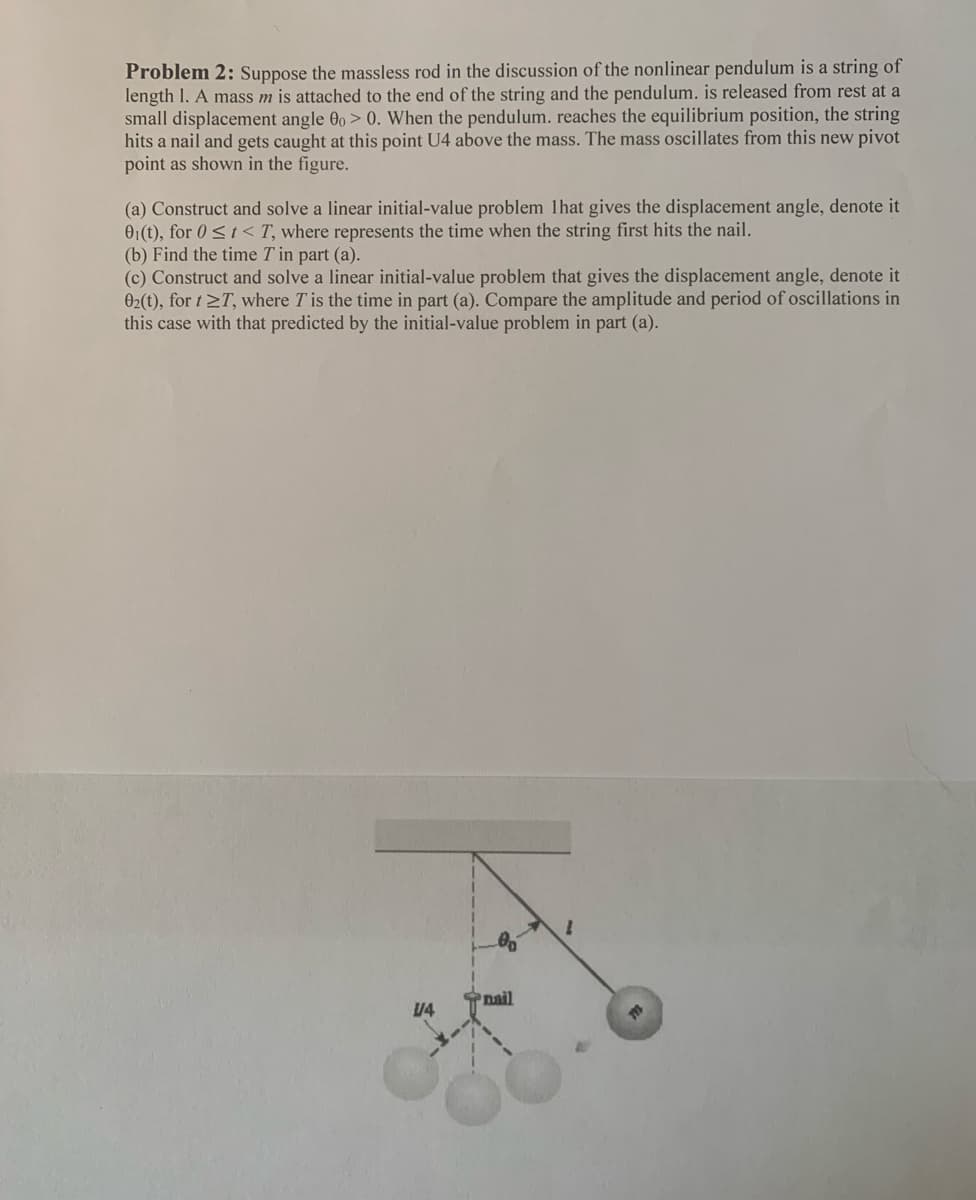Problem 2: Suppose the massless rod in the discussion of the nonlinear pendulum is a string of length 1. A mass m is attached to the end of the string and the pendulum. is released from rest at a small displacement angle 00 > 0. When the pendulum. reaches the equilibrium position, the string hits a nail and gets caught at this point U4 above the mass. The mass oscillates from this new pivot point as shown in the figure. (a) Construct and solve a linear initial-value problem lhat gives the displacement angle, denote it 01(t), for 0≤1
Problem 2: Suppose the massless rod in the discussion of the nonlinear pendulum is a string of length 1. A mass m is attached to the end of the string and the pendulum. is released from rest at a small displacement angle 00 > 0. When the pendulum. reaches the equilibrium position, the string hits a nail and gets caught at this point U4 above the mass. The mass oscillates from this new pivot point as shown in the figure. (a) Construct and solve a linear initial-value problem lhat gives the displacement angle, denote it 01(t), for 0≤1
Elements Of Electromagnetics
7th Edition
ISBN:9780190698614
Author:Sadiku, Matthew N. O.
Publisher:Sadiku, Matthew N. O.
ChapterMA: Math Assessment
Section: Chapter Questions
Problem 1.1MA
Related questions
Question
Q2

Transcribed Image Text:Problem 2: Suppose the massless rod in the discussion of the nonlinear pendulum is a string of
length 1. A mass m is attached to the end of the string and the pendulum. is released from rest at a
small displacement angle 00 > 0. When the pendulum. reaches the equilibrium position, the string
hits a nail and gets caught at this point U4 above the mass. The mass oscillates from this new pivot
point as shown in the figure.
(a) Construct and solve a linear initial-value problem 1hat gives the displacement angle, denote it
01(t), for 0 ≤t< T, where represents the time when the string first hits the nail.
(b) Find the time T in part (a).
(c) Construct and solve a linear initial-value problem that gives the displacement angle, denote it
02(t), for t≥T, where T is the time in part (a). Compare the amplitude and period of oscillations in
this case with that predicted by the initial-value problem in part (a).
00
V4
nail
Expert Solution
This question has been solved!
Explore an expertly crafted, step-by-step solution for a thorough understanding of key concepts.
Step by step
Solved in 6 steps with 6 images

Knowledge Booster
Learn more about
Need a deep-dive on the concept behind this application? Look no further. Learn more about this topic, mechanical-engineering and related others by exploring similar questions and additional content below.Recommended textbooks for you

Elements Of Electromagnetics
Mechanical Engineering
ISBN:
9780190698614
Author:
Sadiku, Matthew N. O.
Publisher:
Oxford University Press

Mechanics of Materials (10th Edition)
Mechanical Engineering
ISBN:
9780134319650
Author:
Russell C. Hibbeler
Publisher:
PEARSON

Thermodynamics: An Engineering Approach
Mechanical Engineering
ISBN:
9781259822674
Author:
Yunus A. Cengel Dr., Michael A. Boles
Publisher:
McGraw-Hill Education

Elements Of Electromagnetics
Mechanical Engineering
ISBN:
9780190698614
Author:
Sadiku, Matthew N. O.
Publisher:
Oxford University Press

Mechanics of Materials (10th Edition)
Mechanical Engineering
ISBN:
9780134319650
Author:
Russell C. Hibbeler
Publisher:
PEARSON

Thermodynamics: An Engineering Approach
Mechanical Engineering
ISBN:
9781259822674
Author:
Yunus A. Cengel Dr., Michael A. Boles
Publisher:
McGraw-Hill Education

Control Systems Engineering
Mechanical Engineering
ISBN:
9781118170519
Author:
Norman S. Nise
Publisher:
WILEY

Mechanics of Materials (MindTap Course List)
Mechanical Engineering
ISBN:
9781337093347
Author:
Barry J. Goodno, James M. Gere
Publisher:
Cengage Learning

Engineering Mechanics: Statics
Mechanical Engineering
ISBN:
9781118807330
Author:
James L. Meriam, L. G. Kraige, J. N. Bolton
Publisher:
WILEY